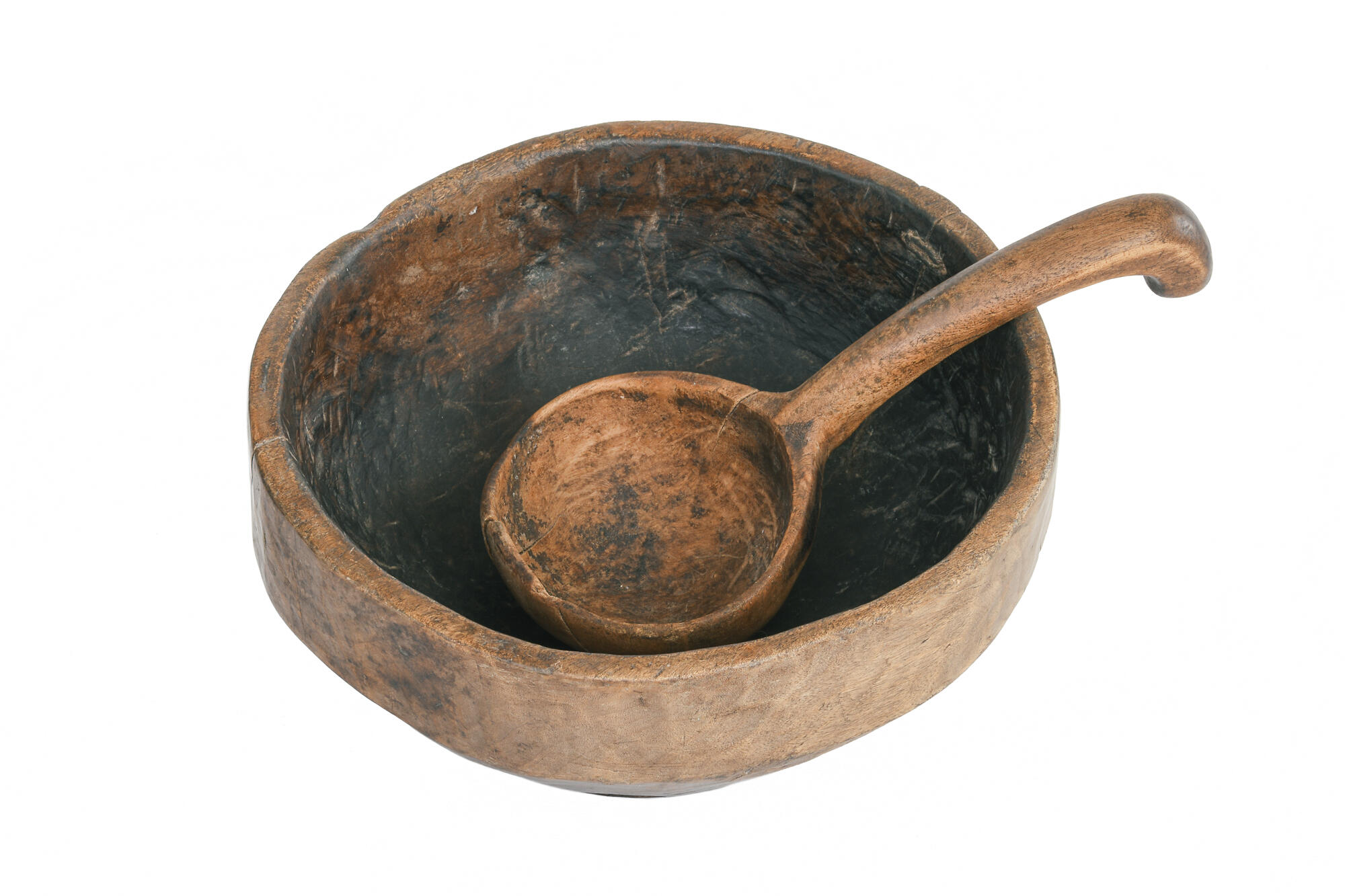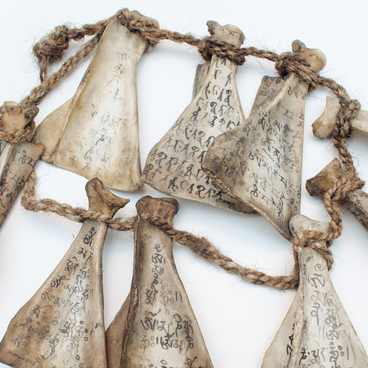The first mention of Khakass kitchenware dates back to the 2nd century BC — the 5th century AD. The household utensils included ladles, bowls and pots, dishes, buckets, and many others.
Khakass household items were most often made of wood. They were light and durable, and therefore appropriate for nomadic lifestyle. The museum’s collection contains national Khakass utensils from the 19th century.
Wooden crockery was kept in special places — on the lower shelves of the second and third walls of the female half of the yurt. According to their tradition, the Khakasses divided the yurt into two parts: reputable and disreputable. The space from the front door to the hearth was called “ot soo”, which translated as “bottom of the fire”. It was viewed to be the disreputable one, so poor relatives were usually seated there. The opposite side, behind the hearth, was called “ot pazy” — “head of the fire” — and was considered worthy of important guests.
There were also male and female halves in the interior of the yurt. The female side — Altynzarykh (north) — was on the right from the entrance. The male side was on the left and was called ustunzarykh (south).
On the women’s side, there were three buffet counters that were all called ‘altynzarkhy paraan’ or ‘altynzarkhy taskhakh’. The lower shelf of the first counter was located next to a wall, so it was also called the door shelf or last shelf. It usually held tubs of ayran and aarchy — a type of cottage cheese. Above the shelf, there were buckets and birch-bark sachets. A tripod made of poles, on which people arranged meat, was placed nearby on the floor, where there was also a hand-made wooden mill, a mortar with a pestle, a grain grinder, and other utensils.
The middle buffet counter was called ‘ulug ilgor’ — a large shelf (also ‘ayakh ilgori’ — a shelf for cups). It consisted of six or seven rows where dishes made of glass, faience, porcelain, and metal were arranged. Cracked cups and plates were no longer put on the shelf. It was believed that such utensils went hand in hand with the dead.
Bottles were stored at the very top of the middle counter. Below, there were silver, copper, and bronze utensils: jugs for drinks, special jugs of water for washing hands called kumgans, and basins. Every Friday, children would polish them with ash mixed with sand and whey. At the very bottom, there were utensils made of pressed leather: wineskins and flasks of different sizes — torsuks and tazors.
The third buffet counter stood by the bed. It was intended for tea utensils. The small shelf (‘kichig ilgor’) consisted of two decks where a samovar, various cups, glasses, and saucers were placed. Two chests (pazakh) and three leather homemade suitcases were kept underneath. They were covered with rugs.
Khakass household items were most often made of wood. They were light and durable, and therefore appropriate for nomadic lifestyle. The museum’s collection contains national Khakass utensils from the 19th century.
Wooden crockery was kept in special places — on the lower shelves of the second and third walls of the female half of the yurt. According to their tradition, the Khakasses divided the yurt into two parts: reputable and disreputable. The space from the front door to the hearth was called “ot soo”, which translated as “bottom of the fire”. It was viewed to be the disreputable one, so poor relatives were usually seated there. The opposite side, behind the hearth, was called “ot pazy” — “head of the fire” — and was considered worthy of important guests.
There were also male and female halves in the interior of the yurt. The female side — Altynzarykh (north) — was on the right from the entrance. The male side was on the left and was called ustunzarykh (south).
On the women’s side, there were three buffet counters that were all called ‘altynzarkhy paraan’ or ‘altynzarkhy taskhakh’. The lower shelf of the first counter was located next to a wall, so it was also called the door shelf or last shelf. It usually held tubs of ayran and aarchy — a type of cottage cheese. Above the shelf, there were buckets and birch-bark sachets. A tripod made of poles, on which people arranged meat, was placed nearby on the floor, where there was also a hand-made wooden mill, a mortar with a pestle, a grain grinder, and other utensils.
The middle buffet counter was called ‘ulug ilgor’ — a large shelf (also ‘ayakh ilgori’ — a shelf for cups). It consisted of six or seven rows where dishes made of glass, faience, porcelain, and metal were arranged. Cracked cups and plates were no longer put on the shelf. It was believed that such utensils went hand in hand with the dead.
Bottles were stored at the very top of the middle counter. Below, there were silver, copper, and bronze utensils: jugs for drinks, special jugs of water for washing hands called kumgans, and basins. Every Friday, children would polish them with ash mixed with sand and whey. At the very bottom, there were utensils made of pressed leather: wineskins and flasks of different sizes — torsuks and tazors.
The third buffet counter stood by the bed. It was intended for tea utensils. The small shelf (‘kichig ilgor’) consisted of two decks where a samovar, various cups, glasses, and saucers were placed. Two chests (pazakh) and three leather homemade suitcases were kept underneath. They were covered with rugs.



